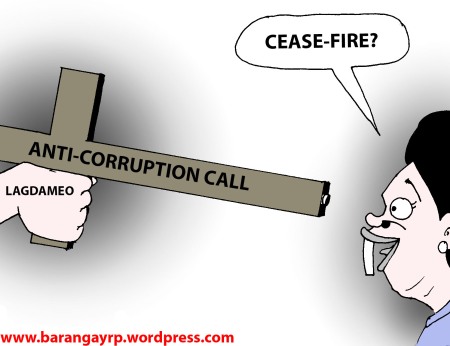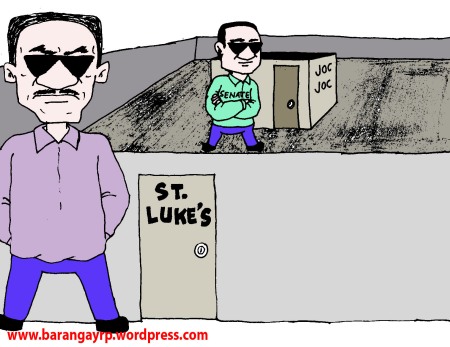
Tabing-dagat sa sa Brgy. Tajao, Pinamungahan, Cebu (Ilang-Ilang Quijano)
ISANG araw noong Mayo 2005, dumating na lamang ang isang malaking barko sa Tañon Strait na matatagpuan sa pagitan ng mga isla ng Cebu at Negros. Isa ang kipot (strait) sa pinakamayamang mga palaisdaan sa Pilipinas at sentro ng marine biodiversity sa mundo.
Dalawang buwang umikot ang M/S Veritas Searcher na may kinakaladkad na 3.5 kilometrong kable sa ilalim ng dagat. Sunud-sunod na pagsabog, na may pagitan lamang na 5 hanggang 20 segundo, ang tanging narinig ng mga mangingisda sa loob ng 24 oras.
Ito ang seismic survey na isinagawa ng Japan Petroleum Exploration Co. Ltd. (Japex) para maghanap ng nakadepositong langis at natural gas. Walang kaalam-alam ang mga mangingisda hinggil sa mga plano ng dayuhang kompanya. Ang alam lang nila, matapos ang sarbey, hindi na nagbalik sa dati ang kanilang buhay.
“Dati rati, nakakahuli kami ng 10-20 kilo ng isda kada araw. Ngayon, 1-2 kilo na lamang,” sabi ni Adriano Agato, 60, tagapangulo ng lokal na grupo ng mangingisda sa Brgy. Tajao, Pinamungahan, Cebu.
 Tinatayang 200,000 mangingisda sa mga probinsiya ng Cebu, Bohol, Negros Oriental, at Negros Occidental ang apektado ng mahigit tatlong taon nang eksplorasyon ng langis ng Japex sa Tañon Strait at NorAsia Energy Ltd. naman sa Cebu-Bohol Strait.
Tinatayang 200,000 mangingisda sa mga probinsiya ng Cebu, Bohol, Negros Oriental, at Negros Occidental ang apektado ng mahigit tatlong taon nang eksplorasyon ng langis ng Japex sa Tañon Strait at NorAsia Energy Ltd. naman sa Cebu-Bohol Strait.
Kamakailan, iniutos ni Gob. Gwendolyn Garcia ang pagtigil ng eksplorasyon ng langis sa Cebu. Pero ayon sa mga makakalikasan at mangingisda, dapat may managot sa malawak nang pinsala, bukod pa sa dapat permanente, di lamang pansamantala, ang nasabing ban.
Kontrata sa DOE
Idineklarang protected seascape ni dating pangulong Fidel V. Ramos ang Tañon Strait na may mayamang konsentrasyon ng lamang-damat. Tahanan ito ng 14 sa 27 uri ng cetacean o pamilya ng mga balyena, dolphin, at porpoise na matatagpuan sa Pilipinas.
Pero tila binasbasan ng gobyernong Arroyo ang simula ng pagkasira ng yamang-dagat sa Tañon Strait at ng kabuhayan ng maliliit na mangingisdang nakadepende rito.
Sa ilalim ng Medium-Term Philippine Development Plan para maabot ang “pagsasarili sa enerhiya” (energy independence), pinirmahan ni Kal. Angelo Reyes ng Department of Energy (DOE) ang 36 service contracts sa iba’t ibang kompanya ng eksplorasyon sa langis at natural gas.
Kabilang dito ang Service Contract 46 sa Japex-Philippines, 100% subsidyaryo ng kompanyang nakabase sa Japan, na pinirmahan noong Disyembre 21, 2004. Saklaw ng kontrata ang 2,850 metro kuwadrado ng Tañon Strait.
May isang bilyong bariles ng potensiyal na reserbang langis sa Tañon Strait at 100 milyong bariles dito ang maaaring marekober, ayon kay Usec. Guillermo Balce ng DOE.
Wala pa mang Environmental Compliance Certificate (ECC) mula sa Department of Environment and Local Resources (DENR) at pagsang-ayon ng mga lokal na yunit ng gobyerno o local government unit (LGU), sinimulan ng Japex ang seismic survey.
Sa sarbey, lumilikha ng ingay ang mga pagsabog (sonic boom) na makapagbibigay ng impormasyon hinggil sa depositong langis at natural gas na maaaring nasa ilalim ng dagat.
May tunog ang sonic boom na 255 decibels, lampas sa hangganan ng tao na 80 db at lalo ng mga hayop na mas mababa pa. Nakasisira ito ng mga organismong dagat at nakakaapekto sa kanilang pagkilos, ayon sa iba’t ibang pananaliksik.
Sa 10-taong siyentipikong pag-aaral ni Dr. Lemuel Aragones, propesor ng Institute of Environment Science and Meteorology sa University of the Philippines, napag-alamang naapektuhan ng seismic survey ng Japex ang pagkilos at pagdami ng mga balyena at dolphin sa Tañon Strait. Dati-rati, halos 300 ang nakikita kada araw. Ngayon ay iilan na lamang.
“Bukod-tangi ang Tañon Strait bilang isang body of water. Napaka-iresponsable para sa gobyerno na payagan ang oil exploration dito. Hindi nila alam kung ano ang masisira,” ani Aragones.
Samantala, noong Hulyo 8, 2005 ipinagkaloob ng DOE sa NorAsia Energy Ltd., isang kompanyang Australyano, ang Service Contract 51 na sumasaklaw sa 4,420 metro kuwadrado ng Cebu-Bohol Strait.
Naghihiwalay sa Cebu at Bohol, isa ang nasabing kipot sa pinakahitik sa mga bakawan (mangrove) at bahura (coral reefs) sa rehiyon. Malapit ito sa Danajon Double Barrier Reef, ang tanging double barrier reef sa Pilipinas at isa sa anim lamang sa buong mundo.
 Sa class suit na inihain sa Korte Suprema noong Disyembre 12, 2007, kinuwestiyon ng Central Visayas Fisherfolks Development Center Inc. (Fidec) at ilang mga kinatawan ng mangingisda ang legalidad ng Service Contract 46.
Sa class suit na inihain sa Korte Suprema noong Disyembre 12, 2007, kinuwestiyon ng Central Visayas Fisherfolks Development Center Inc. (Fidec) at ilang mga kinatawan ng mangingisda ang legalidad ng Service Contract 46.
Wala umanong kapangyarihan ang DOE na pirmahan ang nasabing kontrata na hindi saklaw ng anumang batas. Kung ituturing na kasunduang ehekutibo (executive agreement), dapat pirmado ito ng Pangulo at isinumite muna sa Kongreso para aprubahan.
Labag din ito sa National Integrated Protected Areas System (NIPAS) Act, na nagbabawal ng eksploytasyon at paggamit ng likas-yaman sa protektadong mga erya maliban kung may ipinasang batas ang Kongreso, ayon sa Fidec.
‘Krisis sa isda’
Dulot ng pagkasira ng yamang-dagat sa rehiyon, nagugutom ngayon ang mga mangingisda sa rehiyon. Simula 2005, kinumpirma ng iba’t ibang pag-aaral at Fact-Finding Mission (FFM) ang pagbagsak sa huli ng isda dahil sa operasyon ng Japex at NorAsia.
Sa Tañon Strait, bumagsak sa tatlo hanggang limang kilo mula 15-20 kilo ang huli ng mga mangingisdang may bangkang de-motor, at walang isang kilo hanggang dalawa mula sa apat hanggang anim na kilo ang huli ng mga mangingisdang may bangkang walang motor.
Ito’y ayon sa FFM sa Toledo City, Pinamungahan, at Aloguinsan sa Cebu na pinangunahan ng Fidec at mga grupong mangingisda na Panaghiusa sa Gagmay’ng Mangingisda sa Sugbo (Pamana-Sugbo) at Pambansang Lakas ng Kilusang Mamamalakaya sa Pilipinas (Pamalakaya) noong Setyembre 2005.
Sa Guihulngan City at Vallehermoso sa Negros Oriental at San Carlos City at Calatrava sa Negros Occidental, bumagsak ang huli ng isda sa dalawa hanggang tatlong kilo mula 10-15 kilo, ayon naman sa FFM ng Pamalakaya- Negros noong Nobyembre 2007.
Nasagasaan din ng barko ng Japex ang 136 “payao” o artificial reef ng mga mangingisda roon. Gawa sa Styrofoam, inilalagay ito sa estratehikong mga lugar para dumami ang huli ng isda. Binayaran ang ilang nasirang payao, pero walang natanggap na kompensasyon ang karamihan sa mga may-ari.
Samantala, bumagsak nang 70 hanggang 80 porsiyento ang huli ng isda at kita ng mga mangingisda sa Cebu-Bohol Strait matapos ang seismic survey ng NorAsia noong 2007, ayon sa pag-aaral ng Fidec sa Argao at Sibonga, Cebu.
Tinataya ng Pamalakaya na isang “krisis sa isda” ang nakaamba. Umano’y babagsak ang lokal na produksiyon ng isda nang 600,000 metro tonelada kada taon sa susunod na pito hanggang 10 taon dahil sa eksplorasyon ng langis at natural gas sa Central Visayas.
Mababawasan ang konsumo ng mga Pilipino sa isda nang 20 porsiyento, ayon pa sa grupo.
Fishing ban
Mula Nobyembre 2007 hanggang Pebrero 2008, ipinagbawalan ng Japex ang mga mangingisda sa Pinamungahan at Aloguinsan na lumapit nang pitong kilometro sa Hakoryu V, Mobile Offshore Drilling Unit na kanilang ipinalaot sa gitna ng Tañon Strait.
Panakot nila, mamahalin ang kanilang kagamitan at babayaran ng sinumang makakasira nito. May armadong mga tauhan ding nagbantay sa itinakdang hangganan.
Dahil hindi makapalaot, naglabada, nangahoy, at nagkarpintero na lamang ang mga mangingisda. Tumigil sa pag-aaral ang kanilang mga anak. “Para sa apat na buwang iyon, binigyan lamang kami ng lokal na gobyerno ng tig-isang sako ng bigas,” himutok ni Agato.
Labag sa 1987 Konstitusyon at Philippine Fisheries Code ang fishing ban dahil isinasantabi nito ang karapatan ng maliliit na mangingisda sa komunal na mga palaisdaan sa teritoryo ng bansa, ayon sa Fidec.
Sa offshore drilling, nagbubutas ng balon sa ilalim ng dagat gamit ang mga tubong bakal. Kapag walang natagpuang langis o natural gas, tatakpan ito ng semento bago muling magbutas.
Ang isang binutas na balon ay nagtatapon ng tinatayang 25,000 tonelada ng nakalalasong basura (toxic waste) na may mga kemikal na cadmium, lead, at benzene.
Kinumpirma ng mga residente na iniahon ng Japex ang tone-toneladang toxic waste mula sa dagat at itinatambak sa bakanteng loteng pagmamay-ari ng isang nakatataas na opisyal ng LGU.
“Masangsang ang amoy tuwing inililipat ang basura. Kontaminado ang aming deep well, naging mapait ang tubig. Nagkaroon din kami ng mga sakit sa balat,” sabi ni Alfreda Alcoz, 67, taga-Brgy. Poblacion, Aloguinsan.
Sa kalagitnaan ng taon, nilisan ng mga barko ng Japex ang Tañon Strait. Pahayag ng kompanya sa website nito noong Mayo 13, wala itong natuklasang komersiyal na langis at natural gas.
Pero hanggang ngayon, hindi pa rin bumabalik sa dati ang huli ng isda sa kipot. Maraming lamang-dagat ang biglaang nawala, gaya ng “lumiagan” (isang uri ng pusit) at “baga” (isang uri ng isda).
Samantala, nakaamba ang NorAsia na magsagawa ng offshore drilling sa Cebu-Bohol Strait. Noong Agosto at Setyembre, nagpataw rin ang kompanya ng dalawang linggong fishing ban bilang paghahanda.
“Siguro kapag nagsimula na ang drilling, wala na talaga kaming makakain. Ngayon pa nga lang, kahit pang-ulam, wala,” sabi ni Lucena Sarahena, 41, taga-Brgy. Langtad, Argao.
Bogus na ECC at konsultasyon
Mabuti na lamang na noong Setyembre 22, inilabas ni Garcia ang Executive Order No. 9. Pansamantalang ipinatitigil ang eksplorasyon ng langis at natural gas sa Argao at Sibongan hanggang hindi dumadaan sa masusing konsultasyon.
Ayon sa EO No. 9, nilabag ang nakasaad sa Local Government Code na dapat konsultado ang mga LGU, non-governmental at people’s organizations, at iba pang apektadong sektor ng komunidad bago ipatupad ng gobyerno ang isang proyekto.
Sa Cebu, tanging mga lokal na konseho ng Pinamungahan at Aloguinsan ang nag-apruba sa mga aktibidad ng dayuhang kompanya. Hindi na ito dumaan pa sa LGU sa ibang mga siyudad at probinsiya gaya ng Argao.
“Inilapit sa amin ng NorAsia ‘yung proyekto noong 2005. Pero bago pa namin mapag-aralan, sinimulan na nila ang sarbey. Inulit nila ito (noong 2007). Mga Philippine Coast Guard pa ang eskort nila sa dagat. Talagang sinagasaan ‘yung kapangyarihan namin, siguro, may malakas na backer,” ani Atty. Boyd Arnold Teczon, konsehal at executive director ng Argao Clean and Green Commission, sa isang panayam.
Noong nakaraang buwan, kuwento ni Teczon, dumating ang mga opisyal ng DOE at isang heneral mula sa Maynila para kumbinsihin silang ikauunlad ng munisipyo ang pagmimina sa dagat.
Sa ilalim ng Service Contract System, matatanggap ng gobyerno bilang service fee ang 40 porsiyento ng kita ng kompanyang may kontrata rito.
Nangako rin ang mga opisyal ng NorAsia na bababa ang presyo ng langis at batayang mga bilihin kapag naging matagumpay ang eksplorasyon sa langis at natural gas.
Pero hindi kumbinsido ang mga mangingisda ng Brgy. Langtad. “Ano naman ang pakinabang ng mababang presyo ng mga bilihin kung wala kaming pambili?” sabi ni Felisa Albandonido, 60. “‘Yung kita ng munisipyo, hindi naman talaga mapupunta sa amin,” aniya pa.
Noong nakaraang taon, bumisita ang mga opisyal ng DOE at Japex sa opisina sa Siliman University ni Dr. Angel Alcala, kilalang marine biologist at direktor ng Angelo King Center for Research and Environmental Management, para iprisentang ligtas ang off-shore mining.
Pero nang aralin ni Alcala ang ECC na ipinagkaloob ng DENR- Region VII sa Japex noong Marso 6, 2007, natuklasan niyang “mali” ang pinagbatayan nitong impormasyon. Ang Initial Environmental Examination (IEE) na isinumite ng Japex, luma at kulang ang datos.
Ayon pa sa Fidec, hindi lang dapat nakabatay sa IEE ang ECC ng isang proyektong may kritikal na epekto sa kalikasan, kundi sa Environmental Impact Assessment (EIA). Masinsing konsultasyon at pagsusuri ang daraanan bago makapasa sa EIA.
Malakas na pagtutol
Hinala ng Save Tañon Strait Citizens Movement (STSCM), hindi layon ng E.O. No. 9 na permanenteng pipigilan ang proyekto. Umano’y naghahanda lamang ang NorAsia sa EIA para hindi makasuhan gaya ng Japex.
Noong nakaraang taon binuo ang STSCM, rehiyunal na alyansa ng mga mangingisda, makakalikasan, estudyante, siyentista, abogado at iba pang propesyunal kontra sa off-shore mining. Gaya ng E.O. No. 9, umano’y isa ito sa mga tagumpay ng malakas na pagtutol ng mga mamamayan sa pagdambong sa kanilang karagatan.
Itinutulak ng alyansa ang isang on-site congressional investigation o imbestigasyon ng Kongreso sa erya. Naghain ng mga resolusyon para rito sina Sen. Jamby Madrigal, Sen. Loren Legarda, at 11 kongresista na pinangunahan ni Bayan Muna Rep. Teodoro Casiño.
Samantala, kaliwa’t kanan ang pagsulpot ng lokal na mga grupo ng mangingisda sa mga barangay na saklaw ng Tañon Strait at Cebu-Bohol Strait. Nagsasagawa ang mga ito ng pag-oorganisa, dayalogo sa LGU, pampublikong porum, piket, at malakihang kilos-protesta.
Noong Oktubre 19, World Food Day, mahigit 300 mangingisda ang lumahok sa fluvial protest o protesta sa Tanon Strait na pinangunahan ng Pamana-Sugbo at Pamalakaya.
Lumahok rin sa laban ang internasyunal na komunidad, na nananawagan ng pagpreserba sa marine biodiversity at pagbawas sa pagiging pala-asa sa langis.
Pahayag pa ng International FFM ng People’s Coalition for Food Sovereignty (PCFS) at Pesticide Action Network Asia noong nakaraang buwan, labag sa “karapatang sosyal, pang-ekonomiya, at pangkultura” ng mga mamamayan ang eksplorasyon ng langis at natural gas.
“Nakakabahala na pursigido ang gobyerno ng Pilipinas na ipatupad ang tinatawag na energy development projects sa kabila ng malawakang pagtutol, lalo ng maliliit na mangingisdang pinaka-apektado,” sabi ni Gilbert Sape ng PCFS.
Dagdag pa niya, “Sa Asya at iba pang bahagi ng daigdig, nakikinabang lamang dito ang mga kompanya at tiwaling opisyal ng gobyerno. Hindi yumayaman ang taumbayan sa langis.”
Sa kabaligtaran, lalong naghirap ang mga taga-Central Visayas simula nang malaman nilang may madadambong palang yaman sa ilalim ng dagat, tatlong taon na ang nakakaraan.




 Tinatayang 200,000 mangingisda sa mga probinsiya ng Cebu, Bohol, Negros Oriental, at Negros Occidental ang apektado ng mahigit tatlong taon nang eksplorasyon ng langis ng Japex sa Tañon Strait at NorAsia Energy Ltd. naman sa Cebu-Bohol Strait.
Tinatayang 200,000 mangingisda sa mga probinsiya ng Cebu, Bohol, Negros Oriental, at Negros Occidental ang apektado ng mahigit tatlong taon nang eksplorasyon ng langis ng Japex sa Tañon Strait at NorAsia Energy Ltd. naman sa Cebu-Bohol Strait. Sa class suit na inihain sa Korte Suprema noong Disyembre 12, 2007, kinuwestiyon ng Central Visayas Fisherfolks Development Center Inc. (Fidec) at ilang mga kinatawan ng mangingisda ang legalidad ng Service Contract 46.
Sa class suit na inihain sa Korte Suprema noong Disyembre 12, 2007, kinuwestiyon ng Central Visayas Fisherfolks Development Center Inc. (Fidec) at ilang mga kinatawan ng mangingisda ang legalidad ng Service Contract 46.

 HAYAAN muna ninyong pasalamatan ko ang Karapatan-Ilocos at Dinteg sa Baguio City sa suporta nila sa kaso kong rebelyon sa Condon City. Na-dismiss
HAYAAN muna ninyong pasalamatan ko ang Karapatan-Ilocos at Dinteg sa Baguio City sa suporta nila sa kaso kong rebelyon sa Condon City. Na-dismiss  ANG MATAPANG na pahayag ng limang Katolikong obispo na nanawagan sa mga mamamayan na ”maghanda para sa isang bagong gobyerno,” gayundin ang muling pag-init ng kontrobersiya sa pagbabalik ni Joc-Joc Bolante, ay nagiging tuntungan ngayon ng malawak na kilusang anti-Arroyo upang muling magsama-sama at isikad ang kilusang masa para sa pagpapatalsik sa kinamumuhiang rehimen.
ANG MATAPANG na pahayag ng limang Katolikong obispo na nanawagan sa mga mamamayan na ”maghanda para sa isang bagong gobyerno,” gayundin ang muling pag-init ng kontrobersiya sa pagbabalik ni Joc-Joc Bolante, ay nagiging tuntungan ngayon ng malawak na kilusang anti-Arroyo upang muling magsama-sama at isikad ang kilusang masa para sa pagpapatalsik sa kinamumuhiang rehimen. NARINIG ko sa radyo kahapon (Nobyembre 6) ang balitang hindi na maaaring basahin ng midya’t publiko ang blotter sa anumang istasyon ng pulis kung walang pahintulot ng station commander o kautusan mula sa korte.
NARINIG ko sa radyo kahapon (Nobyembre 6) ang balitang hindi na maaaring basahin ng midya’t publiko ang blotter sa anumang istasyon ng pulis kung walang pahintulot ng station commander o kautusan mula sa korte.





